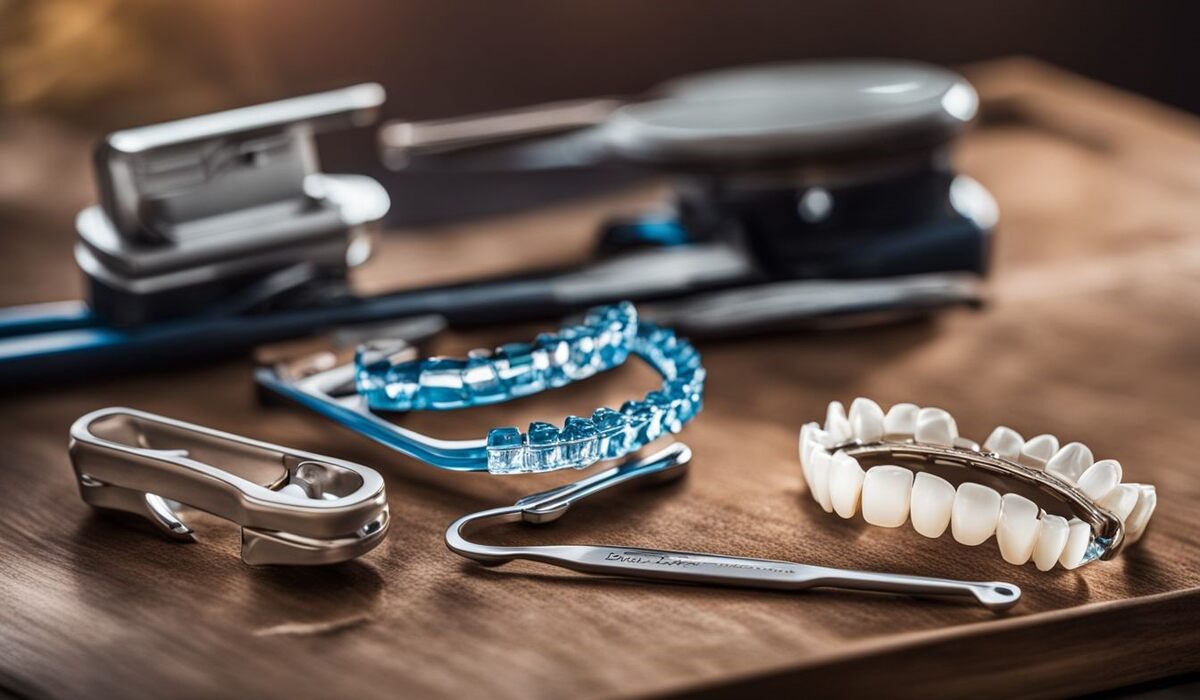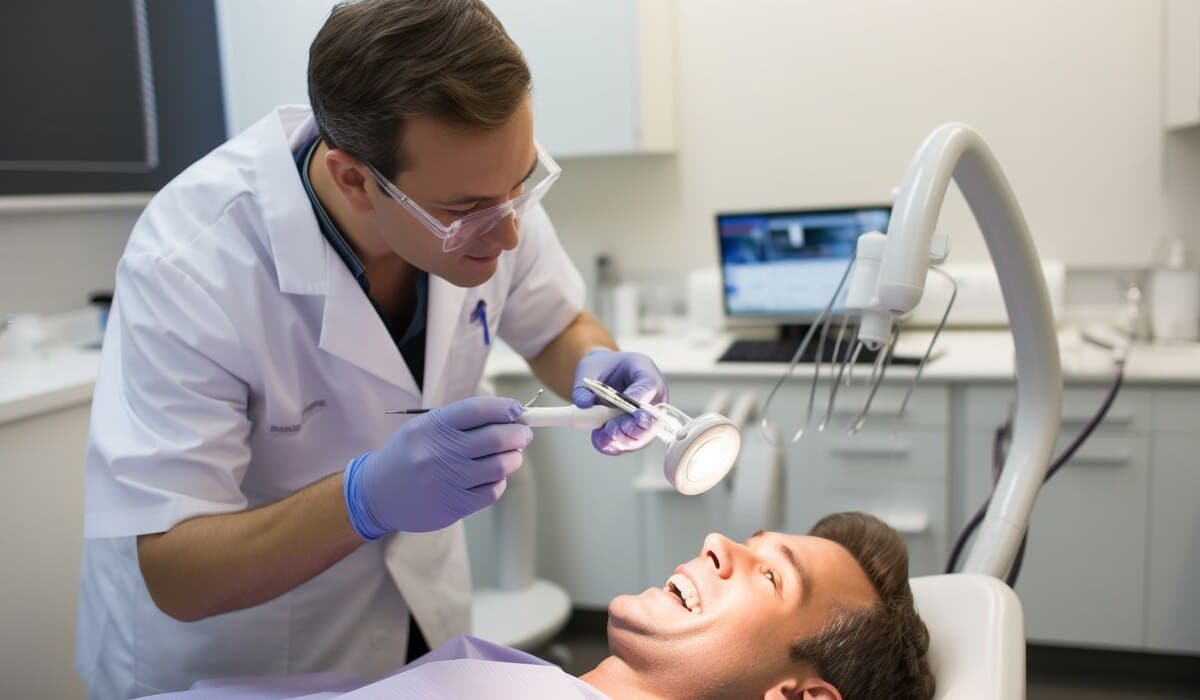Table of Contents
Navigating your way through the maze of orthodontic treatments can be overwhelming, especially when deciding between Invisalign and braces. Despite being a popular choice among adults and teenagers, Invisalign may cost slightly more than traditional braces in Canada – with an average ranging from $2,400 to $6,500.
This blog offers an ultimate guide providing valuable insights on cost comparisons, treatment specifics, aesthetic considerations and how they fit into various lifestyles for both options.
Your journey to a perfect smile starts here – let’s dive in!
Key Takeaways
- Invisalign aligners are virtually invisible and made from clear plastic, while traditional braces are more visible with metal components.
- Invisalign aligners can be easily removed for eating, drinking, and oral hygiene compared to braces that require extra care.
- Both Invisalign and braces can effectively treat a variety of orthodontic conditions such as crowded teeth, gaps, overbites, underbites, crossbites, and open bites.
- Treatment time for traditional braces usually ranges from 18 months to 3 years, while Invisalign treatment typically takes around 12 to 18 months.
Cost Comparison: Invisalign vs Braces

The cost of Invisalign and braces in Canada can vary depending on factors such as the complexity of treatment and the location, with average prices ranging from $3,000 to $8,000.
Factors affecting cost
Several variables influence the cost of braces or Invisalign. Orthodontic treatment price hinges on the complexity of your case, which directly impacts the duration of your treatment.
The geographic location also plays a critical role – treatments in urban areas like Langley, BC, may have higher costs due to overhead expenses. Furthermore, orthodontists’ experience and reputation can impact their rates.
Lastly, each patient’s individual needs and preferences will contribute to total costs – additional features such as clear aligners or streamlined braces come with added expenses. Ultimately, customized treatment plans designed specifically for each patient’s oral health conditions means costs vary significantly from person to person.
Average cost range in Canada
Traditional braces in Canada can require a financial commitment ranging from $2,000 to $6,500. Distinct variations such as streamlined braces provide more choices for patients and add to the cost range spectrum.
Invisalign treatment, on the other hand, carries a price tag typically between $2,400 to $6,500. Despite its slightly higher average cost compared with traditional braces. Many Canadians consider Invisalign due to its unique benefits like removability and discreet appearance.
Keep in mind that these figures are general estimates and individual costs may differ depending on specific orthodontic needs or complications. Factors affecting this include severity of misalignment or bite problems. That need rectification through expert services of an Orthodontist in Langley BC or elsewhere across the country.
No matter which type of treatment you opt for – be it Invisalign or Braces – remember they both have their own merits and demerits. When considering aesthetic preferences and personal factors alongside costs.
Treatment Comparison: Invisalign vs Braces

Invisalign and braces differ in terms of visibility, removability, appointments and adjustments, comfort, hygiene and diet restrictions, conditions treated, and treatment time.
Visibility
Invisalign aligners have the distinct advantage of being virtually invisible. Made from clear, smooth plastic, these aligners blend seamlessly with your teeth making them unnoticeable when worn.
This characteristic has made Invisalign a favored choice among adults and teenagers who want to enhance their smiles subtly. On the other hand, traditional braces are often more visible due to their metal components, even though there are now streamlined models available that tend to be less noticeable than older designs.
Essentially between Invisalign and traditional braces, it’s a matter of how discreet you want your orthodontic treatment to be.
Removability
Invisalign aligners have a distinct advantage over traditional braces because they are removable. This means that you can easily take them out when eating, drinking, brushing your teeth. Or participating in activities where you prefer not to wear them.
The ability to remove the aligners makes maintaining oral hygiene much easier compared to braces. As you can thoroughly brush and floss your teeth without any obstructions. Additionally, being able to take out the aligners also allows for more freedom when it comes to enjoying your favorite foods and beverages.
With Invisalign, you won’t have to worry about restrictions on what you can eat or drink during treatment.
Appointments and adjustments
Orthodontic treatment, whether with Invisalign or braces, requires regular appointments and adjustments. Throughout the course of treatment, patients will need to visit their orthodontist in Langley, BC for check-ups and progress evaluations.
These appointments are crucial for monitoring the teeth straightening process and ensuring that everything is progressing as planned. Adjustments may also be made during these visits to fine-tune the alignment of the teeth.
Whether it’s tightening wires on traditional braces or receiving a new set of aligners with Invisalign, these adjustments help to gradually move the teeth into their desired positions.
Regular attendance at these appointments is essential for successful orthodontic treatment.
It’s important to note that the frequency of appointments and adjustments will vary depending on individual cases and treatment plans. Your orthodontist in Langley, BC will provide specific instructions regarding how often you should come in for visits throughout your orthodontic journey.
Comfort
Both Invisalign and braces provide effective teeth straightening, but there are differences in terms of comfort. Invisalign aligners are made from smooth plastic and have no sharp edges, making them more comfortable to wear compared to traditional braces.
The aligners are custom-fit to ensure a snug fit and minimize discomfort. With Invisalign, there is also no need for metal wires or brackets that can irritate the gums and cheeks. This makes Invisalign a popular choice among individuals who prioritize comfort during their orthodontic treatment journey.
Hygiene and diet restrictions
Maintaining good oral hygiene is important during orthodontic treatment, regardless of whether you choose Invisalign or braces. With traditional braces, it can be a bit more challenging to keep your teeth clean due to the wires and brackets.
However, with Invisalign aligners, you can simply remove them when brushing and flossing your teeth. Also, making it easier to maintain proper oral hygiene. As for diet restrictions, while wearing braces you may need to avoid sticky or hard foods that could damage the wires or brackets.
On the other hand, with Invisalign aligners, there are no specific food restrictions since they are removable during meal times. It’s always best to follow any advice provided by your orthodontist regarding oral hygiene and diet throughout your treatment journey.
Conditions treated
Invisalign and traditional braces can effectively treat a wide range of orthodontic conditions. Both options are capable of correcting crowded or misaligned teeth, gaps between teeth, overbites, underbites, crossbites, and open bites.
With their expertise, they can help determine the best approach to achieve optimal results for your specific condition.
Treatment time
Treatment time is an important factor to consider when deciding between Invisalign and braces. On average, traditional braces require a treatment period of 18 months to 3 years. This duration may vary depending on the complexity of the case and how well patients comply with their orthodontist’s instructions.
In contrast, Invisalign treatment usually takes around 12 to 18 months. The aligners are changed every few weeks, gradually shifting the teeth into the desired position. It’s worth noting that each patient’s situation is unique, so it’s essential to consult with an orthodontist who can provide a more accurate estimate based on individual needs and goals.
Aesthetic Preferences and Personal Factors
Discover how your aesthetic preferences and personal factors play a crucial role in deciding between Invisalign and braces for your orthodontic treatment.
Aesthetic preferences
Aesthetic preferences play a significant role in deciding between Invisalign and braces. Invisalign aligners are made from clear, smooth plastic, making them virtually unnoticeable when worn.
This makes them a popular choice among adults and teenagers who may be self-conscious about the appearance of traditional braces. On the other hand, some individuals prefer the look of traditional braces as they come in colorful options or even with gold brackets for added style.
Ultimately, it comes down to personal preference and how comfortable you feel wearing either option throughout your orthodontic treatment journey.
Lifestyle considerations
Considerations for your lifestyle should play a significant role in deciding between Invisalign and braces. If you lead an active lifestyle or participate in contact sports. Traditional braces may be a better option as they provide more stability and durability during physical activities.
On the other hand, if you value convenience and want the flexibility to remove your orthodontic treatment. When necessary (e.g., for special occasions), then Invisalign’s removability would be a favorable feature.
Additionally, if maintaining good oral hygiene is essential to you, Invisalign aligners can be easily removed for brushing and flossing compared to traditional braces. Which have wires that require extra care while cleaning.
Overall responsibility required
Taking on orthodontic treatment, whether with Invisalign or braces, requires a level of overall responsibility. This includes diligently following the instructions provided by your orthodontist and committing to regular appointments for adjustments and check-ups.
You will be responsible for maintaining good oral hygiene throughout the treatment process, including brushing and flossing regularly to keep your teeth and braces clean. It’s important to follow any dietary restrictions recommended by your orthodontist to avoid damage to your braces or aligners.
Additionally, you will need to remain committed to wearing your aligners for the recommended amount of time each day for optimal results. By taking on this responsibility, you can ensure that you achieve the best possible outcome from your orthodontic treatment journey.
Making the Decision: Invisalign vs Braces
When deciding between Invisalign and braces, it’s important to consult with a specialist and consider factors such as cost, personal preferences and lifestyle, long-term results and maintenance, as well as the best offers and options available.
Consulting with a specialist
Consulting with a specialist is an essential step when considering orthodontic treatment. An experienced orthodontist can provide personalized advice based on your specific needs and goals.
They will evaluate your dental health, assess the alignment of your teeth, and recommend the most suitable treatment options for you. During the consultation, you can ask questions about cost, treatment duration, and any concerns you may have.
This expert guidance will ensure that you make an informed decision and choose the right option – whether it’s Invisalign or braces – to achieve a straighter smile.
Considering cost and treatment factors
- Invisalign and traditional braces should be compared based on their cost and various treatment factors before making a decision.
- The average cost for braces in Canada ranges from $2,000 to $9,700, while Invisalign typically falls within the range of $2,400 to $6,500.
- Factors such as the severity of the dental issue, treatment duration, and any additional procedures required can affect the overall cost.
- Patients should also consider the long – term maintenance costs associated with each option when assessing their budget.
- Treatment factors to consider include visibility (braces are more noticeable), removability (Invisalign can be taken out for eating and cleaning), appointments and adjustments (braces require regular visits), comfort (Invisalign aligners are smooth and don’t cause irritation like braces), hygiene (keeping teeth clean is easier with Invisalign), diet restrictions (some foods may need to be avoided with braces), and conditions treated (both options can effectively treat various orthodontic issues).
- It is important to consult with a dental specialist who can provide personalized advice based on individual circumstances and preferences.
Personal preferences and lifestyle
Personal preferences and lifestyle play a crucial role in deciding between Invisalign and braces. Some individuals may prefer the discreteness of Invisalign aligners, as they are clear, smooth plastic trays that are virtually unnoticeable when worn.
This makes them popular among adults and teenagers who may feel self-conscious about wearing traditional metal braces. Additionally, the ability to remove Invisalign aligners allows for more flexibility in terms of eating and oral hygiene maintenance compared to braces.
On the other hand, some individuals may prefer the reliability and durability of traditional braces, which cannot be removed or lost like removable aligners. It is important to consider personal comfort levels with both options before making a decision on orthodontic treatment.
Long-term results and maintenance
Maintaining long-term results is crucial after completing orthodontic treatment with either Invisalign or braces. Both options can effectively straighten teeth, but it’s essential to follow proper maintenance practices to ensure lasting outcomes.
Regular dental check-ups and cleanings are important for monitoring oral health and preventing issues like cavities or gum disease. Additionally, wearing retainers as prescribed by the orthodontist helps maintain the new position of the teeth and prevent relapse.
Proper oral hygiene habits such as brushing twice a day, flossing daily. Further, avoiding sticky foods also contribute to maintaining long-term results and overall dental health.
Best offers and options available
There are several options to consider when it comes to the best offers and choices available for orthodontic treatment in Canada. Many orthodontists offer flexible payment plans and financing options, making it easier for patients to afford the cost of treatment.
Additionally, some dental insurance plans may cover a portion of the expenses associated with braces or Invisalign. It’s important to consult with a specialist who can provide information on the different offers and options available.Also, taking into account your personal preferences, budget, and long-term goals.
Conclusion
In conclusion, when considering the choice between Invisalign and braces, it’s important to weigh factors. Such as cost, treatment time, visibility, comfort, hygiene, and personal preferences.
While Invisalign tends to be slightly more expensive than traditional braces in Canada. It offers the advantage of being removable and virtually unnoticeable when worn. On the other hand, braces may be a more suitable option for those with complex dental issues or who prefer a fixed treatment method.
Ultimately, consulting with an orthodontist is crucial in making an informed decision that aligns with your specific needs and treatment goals. With their expertise and guidance, you can achieve the straighter smile you desire.
FAQs
1. What is Canada’s ultimate guide to Invisalign vs Braces all about?
Canada’s ultimate guide provides detailed comparison between Invisalign and braces treatments, offered by an Orthodontist in Langley.
2. How can a Langley Orthodontist help me choose between Invisalign and braces?
A Langley Orthodontist has the professional expertise to analyze your dental conditions and recommend either Invisalign or braces based on your unique needs.
3. Are there specific advantages of visiting an Orthodontist in Langley for Invisalign or braces consultation?
Yes, visiting an Orthodontist in Langley could provide you up-to-date information about the latest advancements in both the treatments helping you make informed decisions.
4. Is it necessary to consult a Langley Orthodontist before deciding on my treatment type?
While not mandatory, consulting a Langley orthodontist is advisable as they can holistically guide you through choosing the most suitable form of treatment -be it invisalign or traditional braces.


